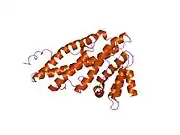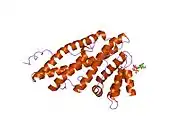PICALM
Phosphatidylinositol binding clathrin assembly protein, also known as PICALM, is a protein which in humans is encoded by the PICALM gene.[5]
Clinical significance
In humans, certain alleles of this gene have been statistically associated with an increased risk of developing late-onset Alzheimer's disease.[7]
References
- GRCh38: Ensembl release 89: ENSG00000073921 - Ensembl, May 2017
- GRCm38: Ensembl release 89: ENSMUSG00000039361 - Ensembl, May 2017
- "Human PubMed Reference:". National Center for Biotechnology Information, U.S. National Library of Medicine.
- "Mouse PubMed Reference:". National Center for Biotechnology Information, U.S. National Library of Medicine.
- "Entrez Gene: PICALM phosphatidylinositol binding clathrin assembly protein".
- Tebar, F; Bohlander S K; Sorkin A (Aug 1999). "Clathrin assembly lymphoid myeloid leukemia (CALM) protein: localization in endocytic-coated pits, interactions with clathrin, and the impact of overexpression on clathrin-mediated traffic" (PDF). Mol. Biol. Cell. UNITED STATES. 10 (8): 2687–702. doi:10.1091/mbc.10.8.2687. ISSN 1059-1524. PMC 25500. PMID 10436022.
- Harold D, Abraham R, Hollingworth P, et al. (September 2009). "Genome-wide association study identifies variants at CLU and PICALM associated with Alzheimer's disease". Nat. Genet. 41 (10): 1088–93. doi:10.1038/ng.440. PMC 2845877. PMID 19734902. Lay summary – TIME Magazine (2009-09-06).
Further reading
- Ron D, Habener JF (1992). "CHOP, a novel developmentally regulated nuclear protein that dimerizes with transcription factors C/EBP and LAP and functions as a dominant-negative inhibitor of gene transcription". Genes Dev. 6 (3): 439–53. doi:10.1101/gad.6.3.439. PMID 1547942.
- Dreyling MH, Martinez-Climent JA, Zheng M, et al. (1996). "The t(10;11)(p13;q14) in the U937 cell line results in the fusion of the AF10 gene and CALM, encoding a new member of the AP-3 clathrin assembly protein family". Proc. Natl. Acad. Sci. U.S.A. 93 (10): 4804–9. Bibcode:1996PNAS...93.4804D. doi:10.1073/pnas.93.10.4804. PMC 39360. PMID 8643484.
- Silliman CC, McGavran L, Wei Q, et al. (1998). "Alternative splicing in wild-type AF10 and CALM cDNAs and in AF10-CALM and CALM-AF10 fusion cDNAs produced by the t(10;11)(p13-14;q14-q21) suggests a potential role for truncated AF10 polypeptides". Leukemia. 12 (9): 1404–10. doi:10.1038/sj.leu.2401109. PMID 9737689.
- Tebar F, Bohlander SK, Sorkin A (1999). "Clathrin assembly lymphoid myeloid leukemia (CALM) protein: localization in endocytic-coated pits, interactions with clathrin, and the impact of overexpression on clathrin-mediated traffic". Mol. Biol. Cell. 10 (8): 2687–702. doi:10.1091/mbc.10.8.2687. PMC 25500. PMID 10436022.
- Kim JA, Kim SR, Jung YK, et al. (2000). "Properties of GST-CALM expressed in E. coli". Exp. Mol. Med. 32 (2): 93–9. doi:10.1038/emm.2000.17. PMID 10926122. S2CID 9913485.
- Wechsler DS, Engstrom LD, Alexander BM, et al. (2003). "A novel chromosomal inversion at 11q23 in infant acute myeloid leukemia fuses MLL to CALM, a gene that encodes a clathrin assembly protein" (PDF). Genes Chromosomes Cancer. 36 (1): 26–36. doi:10.1002/gcc.10136. PMID 12461747. S2CID 6463540.
- Strausberg RL, Feingold EA, Grouse LH, et al. (2003). "Generation and initial analysis of more than 15,000 full-length human and mouse cDNA sequences". Proc. Natl. Acad. Sci. U.S.A. 99 (26): 16899–903. Bibcode:2002PNAS...9916899M. doi:10.1073/pnas.242603899. PMC 139241. PMID 12477932.
- Ota T, Suzuki Y, Nishikawa T, et al. (2004). "Complete sequencing and characterization of 21,243 full-length human cDNAs". Nat. Genet. 36 (1): 40–5. doi:10.1038/ng1285. PMID 14702039.
- Brandenberger R, Wei H, Zhang S, et al. (2005). "Transcriptome characterization elucidates signaling networks that control human ES cell growth and differentiation". Nat. Biotechnol. 22 (6): 707–16. doi:10.1038/nbt971. PMID 15146197. S2CID 27764390.
- Park SY, Ha BG, Choi GH, et al. (2004). "EHD2 interacts with the insulin-responsive glucose transporter (GLUT4) in rat adipocytes and may participate in insulin-induced GLUT4 recruitment". Biochemistry. 43 (23): 7552–62. doi:10.1021/bi049970f. PMID 15182197.
- Gerhard DS, Wagner L, Feingold EA, et al. (2004). "The status, quality, and expansion of the NIH full-length cDNA project: the Mammalian Gene Collection (MGC)". Genome Res. 14 (10B): 2121–7. doi:10.1101/gr.2596504. PMC 528928. PMID 15489334.
- Meyerholz A, Hinrichsen L, Groos S, et al. (2006). "Effect of clathrin assembly lymphoid myeloid leukemia protein depletion on clathrin coat formation". Traffic. 6 (12): 1225–34. doi:10.1111/j.1600-0854.2005.00355.x. PMID 16262731. S2CID 8040699.
- Archangelo LF, Gläsner J, Krause A, Bohlander SK (2006). "The novel CALM interactor CATS influences the subcellular localization of the leukemogenic fusion protein CALM/AF10". Oncogene. 25 (29): 4099–109. doi:10.1038/sj.onc.1209438. PMID 16491119.
- Deshpande AJ, Cusan M, Rawat VP, et al. (2007). "Acute myeloid leukemia is propagated by a leukemic stem cell with lymphoid characteristics in a mouse model of CALM/AF10-positive leukemia". Cancer Cell. 10 (5): 363–74. doi:10.1016/j.ccr.2006.08.023. PMID 17097559.
- Abdelhaleem M, Beimnet K, Kirby-Allen M, et al. (2007). "High incidence of CALM-AF10 fusion and the identification of a novel fusion transcript in acute megakaryoblastic leukemia in children without Down's syndrome". Leukemia. 21 (2): 352–3. doi:10.1038/sj.leu.2404503. PMID 17170719.
- Ashihara E, Nakamura S, Inaba T, et al. (2007). "A novel AF10-CALM fusion transcript in gamma/delta-T cell type lymphoblastic lymphoma". Am. J. Hematol. 82 (9): 859–60. doi:10.1002/ajh.21021. PMID 17597474. S2CID 72275219.
- Caudell D, Zhang Z, Chung YJ, Aplan PD (2007). "Expression of a CALM-AF10 fusion gene leads to Hoxa cluster overexpression and acute leukemia in transgenic mice". Cancer Res. 67 (17): 8022–31. doi:10.1158/0008-5472.CAN-06-3749. PMC 1986634. PMID 17804713.
This article is issued from Wikipedia. The text is licensed under Creative Commons - Attribution - Sharealike. Additional terms may apply for the media files.











